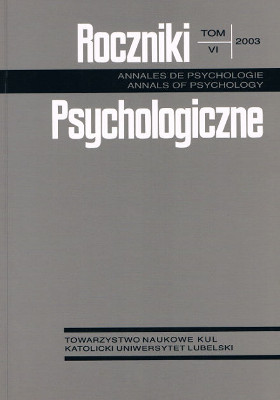Subjectivity and multiplicity of „sub-realities” according to William James
Abstract
In W. James's studies the author seeks an answer to the question: What is/For whom is it real? The largest number of interesting suggestions one can find in the 21st chapter of his Principles of Psychology. Many of them are linked with somewhat different, although equally interesting question – when, under what circumstances, are we willing to treat a given „object” as something real. James say, among other things, about direction of attention, about the relation to self, triggering of emotions, and about sensorial values of such objects. The author of the paper emphasizes the current character of the problem of the „perception of realness. „ The intuitive solutions and proposals put forward by James can be empirically verified as well.
References
Bruner, J. (1986). Actual minds, possible worlds. Cambridge–Massachusetts–London: Harvard University Press.
Buczyńska-Garewicz, H. (1973). James. Warszawa: Wiedza Powszechna.
Chwistek, L. (1918/1960). Wielość rzeczywistości w sztuce. W: K. Estreicher (red.), Wielość rzeczywistości w sztuce i inne szkice literackie. Warszawa: Czytelnik, s. 25-50.
Chwistek, L. (1921/1961). Wielość rzeczywistości. W: K. Pasenkiewicz (red.), Pisma filozoficzne i logiczne (t. 1). Warszawa: PWN, s. 31-127.
Gibson, J. J. (1079). The ecological approach to visual perception. Boston: Houghton Mifflin.
Giorgi, A. (2002). Psychologia jako nauka uprawiana z ludzkiej perspektywy. Podejście fenomenologiczne. Białystok: Trans Humana.
Glasersfeld, E. von (1987). Poznanie jako samoregulacja. Etapy konstrukcji `innych' i `rzeczywistości'. W: W. Gasparski, D. Miller (red.), Projektowanie i systemy (t. 9). Wrocław: Ossolineum, s. 93-100.
Glasersfeld, E. von (1995). Radical constructivism: A way of knowing and learning. London: The Falmer Press.
Glasersfeld, E. von (1996). Farewell to objectivity. Systems Research, 13, 279-286.
James, W. (1890). The principles of psychology (vol. II). New York: Holt. Dostępne również: http: //psychclassics.yorku.ca/James/Principles/prin21.htm [Accessed 03 March 2003].
James, W. (1973). Jedność i wielość (fragment książki Some problems of philosophy). W: H. Buczyńska-Garewicz. James. Warszawa: Wiedza Powszechna, s. 167-182.
James, W. (2001/1902). Doświadczenia religijne. Kraków: Zakład Wydawniczy „NOMOS”.
Koepsell, D. R. (1999). Introduction to applied ontology: The philosophical analyses of everyday objects. American Journal of Economics and Socjology, 58, 217-220. Dostępne również: http: //www.findarticles.comcfdls/m0254/258/55084086/print.jhtml [Accessed 21 Juni 2003].
LeShan, L. (1976). Alternate realities. The search for the full human being. New York: Ballantine Books.
Manterys, A. (1997). Wielość rzeczywistości w teoriach socjologicznych. Warszawa: Wydawnictwo Naukowe PWN.
Maturana, H. R., Varela, F. G. (1980). Autopoiesis and cognition. Dordrecht: Reidel.
Maturana, H. R. (1988). Reality: The search for objectivity or the quest fo compelling argument. Irish Journal of Psychology, 9, 25-82. Dostępne również: http: //www.ozemail.com. au/~jcull/reality.htm [Accessed 8 Juni 2002].
Mudyń, K. (1993). Między świadomością rzeczywistości a rzeczywistością świadomości. Gestalt, 11, 24-28.
Mudyń, K. (1997/1995). O sposobach istnienia `rzeczywistości' w odmiennych stanach świadomości. W: K. Mudyń, Zdarza się, że myślimy... Kraków: Wydawnictwo PSB, s. 185-203.
Mudyń, K. (2000). W stronę fenomenologii istnienia. Dlaczego Kraków wydaje się bardziej rzeczywisty niż Wszechświat? W: P. Moroz, J. Hańderek (red.), Oblicza fenomenologii Kraków: Wydawnictwo Collegium Columbinum, s. 261-278. Dostępne również: http: //www.cyberforum.edu.pl/teksty.php3.
Mudyń, K. (2002a). O wielości rzeczywistości w koncepcji Leona Chwistka (i mnogości osobowości jej autora). Maszynopis dostępny w Redakcji Przeglądu Filozoficznego.
Mudyń, K. (2002b). Preferowane wartości a ocena stopnia realności desygnatów odpowiednich pojęć. Referat wygłoszony na XXXI Zjeździe Naukowym PTP, Lublin, 5-8 września 2002, s. 187.
Mudyń, K. (2002c). Technoświadomość. O zmieniającym się poczuciu realności i własnej tożsamości u użytkowników cyberprzestrzeni. W: D. Jasiecka (red.), Człowiek wobec zmiany. Rozważania psychologiczne. Kraków: Wydawnictwo UJ, s. 145-156.
Searle, J. R. (1995). The construction of social reality. New York: The Free Press.
Searle, J. R. (1999). Umysł, język, społeczeństwo. Filozofia i rzeczywistość. Warszawa: Wyd. CiS i WAB.
Smith, B. (1999). Ontology with human subjects testing: An empirical investigation of geographic categories. American Journal of Economics and Socjology, 58, 245-272. Dostępne również: http: //www.findarticles.com/cf_dls/m0254/2_58/55084089/print.jhmtl [Accessed 21 Juni 2003].
Tart, Ch. T. (red.) (1969). Altered states of consciousness. New York: Wiley.
Tart, Ch. T. (1975). States of consciousness. New York: E. P. Dutton & Co.
Tart, Ch. T. (1980). The system approach to consciousness. W: R. N. Walsh, F. Vaughan (red.), Beyond ego. Transpersonal dimensions in psychology. Los Angeles: P. Tarcher Inc., s. 115-118.
Tart, Ch. T. (1990). Multiple personality, altered states and virtual reality: The world simulation process approach. Dissociation, 3, 222-233.
Copyright (c) 2003 Roczniki Psychologiczne

This work is licensed under a Creative Commons Attribution-NonCommercial-NoDerivatives 4.0 International License.


